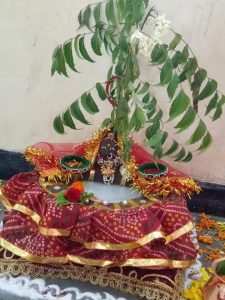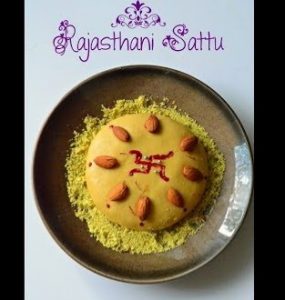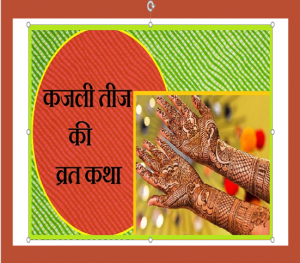
| Pooja Vidhi |
Teej is a monsoon festival and a welcome relief after the sweltering summer season. Women in India celebrate Teej festival in honor of the Goddess Parvati and her union with Lord Shiva throughout the country. It is celebrated on the third day after Amavasya (new moon) or on the third day after Poornima (full moon) in the months of Shravan and Bhaadrapad.
In Northern and Western states of Indian three main teej festivals are held in the monsoon season. In Rajasthan ans some northern states they are known as Haryali Teej, Kajali Teej and Hartalika Teej. Haryali teej celebrated on teej of Krishna Paksh (period of waning moon) in the month of Shravan (July – August). Kajali Teej (Main Teej festival) on teej of Krishna Paksh in the month of Bhaadrapad (August – September), and Hartalika teej on the teej of the Shukla Paksh (period of waxing moon) in the month of Bhaadrapad (August – September). In Gujarat it is celebrated as Gowri Pooja and in Mahashtra the festival is also referred to as Mangala Gowri. In Maharashtra even though Goddess Gauri is recognized as the sister of Lord Ganesha, she represents Goddess Parvati , the mother of Ganesha. In the Southern states of India it is celebrated as Swarna Gowri Vratha (day of the golden Goddess Parvati). Whatever name the festival of teej may be known by in different regions of India it is a celebration in honor of Goddess Parvati and a time when women ask for blessings from her for marital bliss and prosperity for their families.
In Rajasthan, the desert state of India the teej festivals are especially significant. The blooming of the desert after the monsoons rains fills the parched desert landscape with greenery and color. As farming communities reap a good harvest the season calls for much celebration. The hot days of summer give way to cooler days and people are able to go to parks and other picnic spots by lakes to enjoy the outdoors. Swings are hung from trees so people can enjoy the cool breeze, and singing and dancing along with games are very much part of the merry making. Prior to the start of any teej festival women apply Mehendi and get ready for the festival. It is called “Sinjara” in Rajasthan and on this day husbands and family members pamper them and give them with new clothes and gifts.
It is not surprising that the first teej festival of the monsoon season is called Haryali (greenery) Teej or Chhoti (small) Teej. It is said that Goddess Parvati also known as Teej Mata (Mata = Mother) fell in love with the ascetic Shiva. She performed penance for 108 years focusing all her love and devotion on Shiva and finally married him. The devotion and perseverance of Parvati to attain Shiva, her choice for a life partner and their eternal blissful marital relationship is what women pray for on this day. On this day girls pray to get a husband like Shiva and women seek blessings of Goddess Parvati so that they like her will be always united with their husbands in every birth. In Brindavan and Uttar Pradesh hariyali teej festival is connected with Lord Krishna and Radha and is known as Jhulan (Swing) Teej or Hindola (swing) Teej. Radha Krishna images are set up in swings that are beautifully decorated every day. The festivities last for 13 days and end with Janmashtami.
Kajali Teej also known as Badi (big or main) Teej is celebrated in a grand way. Women fast all day and pray together in the evening. A tender small Neem branch is planted in a plate full of water to recreate the water filled lakes and the sweet neem trees around it. The Nimdi (tender neem branch)(sweet neem) tree represents Goddess Parvati. Women perform pooja and see reflections of “suhaag” items or marks of a married woman in the water like bangles, chundadi (red saree with tie and dye pattern), nose ring, pearls, and gold, along with lemon and cucumber, and the sattu (made from either wheat flour, rice or newly harvested chik pea flour and sugar and ghee)(special sweet prepared from newly harvested chick pea flour). Women offer prayers to the moon at night. After this the husbands cut the sattu cake and feed their wives to break the fast. This is always accompanied by much laughter and teasing. Sattu is also made for the boys of the family. They boys cut the sattu so that whoever is fasting for their wellbeing can break their fast and hope that they will meet the person destined for them. Girls fast, prepare sattu, perform pooja and pray to Goddess Parvati to bless them with a husband of their choice. It is a big family event and the rituals, singing and dancing that accompany this festival is a great reminder to both the husband and wife of their love commitment to each other.
The story connected with Hartalika (harita = abduction, alika = friend) teej is about the time when Goddess Parvati was born as the daughter of Himavan, the kind of the Himalayas. Right from childhood her heart was set on marrying the great Shiva even though he was an ascetic and always deep in meditation. She performed severe penances to draw his attention but did not succeed. One day, Narada approached the king with a proposal from Vishnu who wanted to marry his daughter. The king who was worried about Parvati’s failed penances accepted the proposal. This angered Parvati and left home to stay with a friend. To avoid being found by her father her friend took her to a remote forest where she continued her penance and finally won Shiva’s hand in marriage. When Himavan her father agrees to the marriage she returns home. During this three-day festival women hold a nirjala (without water) fast to mimic the severe penances of Parvati and pray to the Goddess to bless them with a husband like Shiva and grant them the same marital bliss she experienced with him.
Just as the life-giving rains rejuvenate the earth during the monsoon season women ask Goddess Parvati to shower them with marital bliss, happiness, and prosperity.



